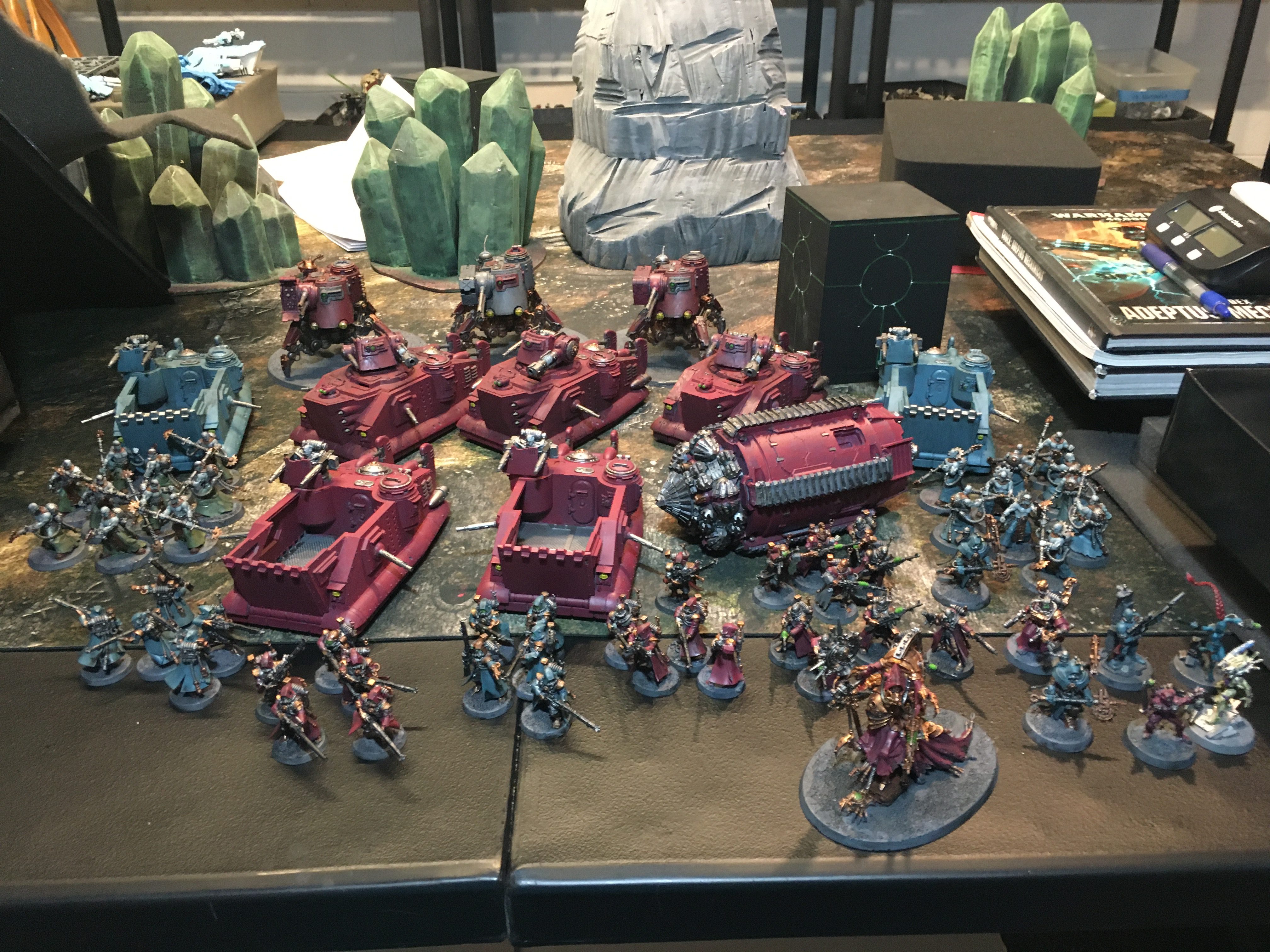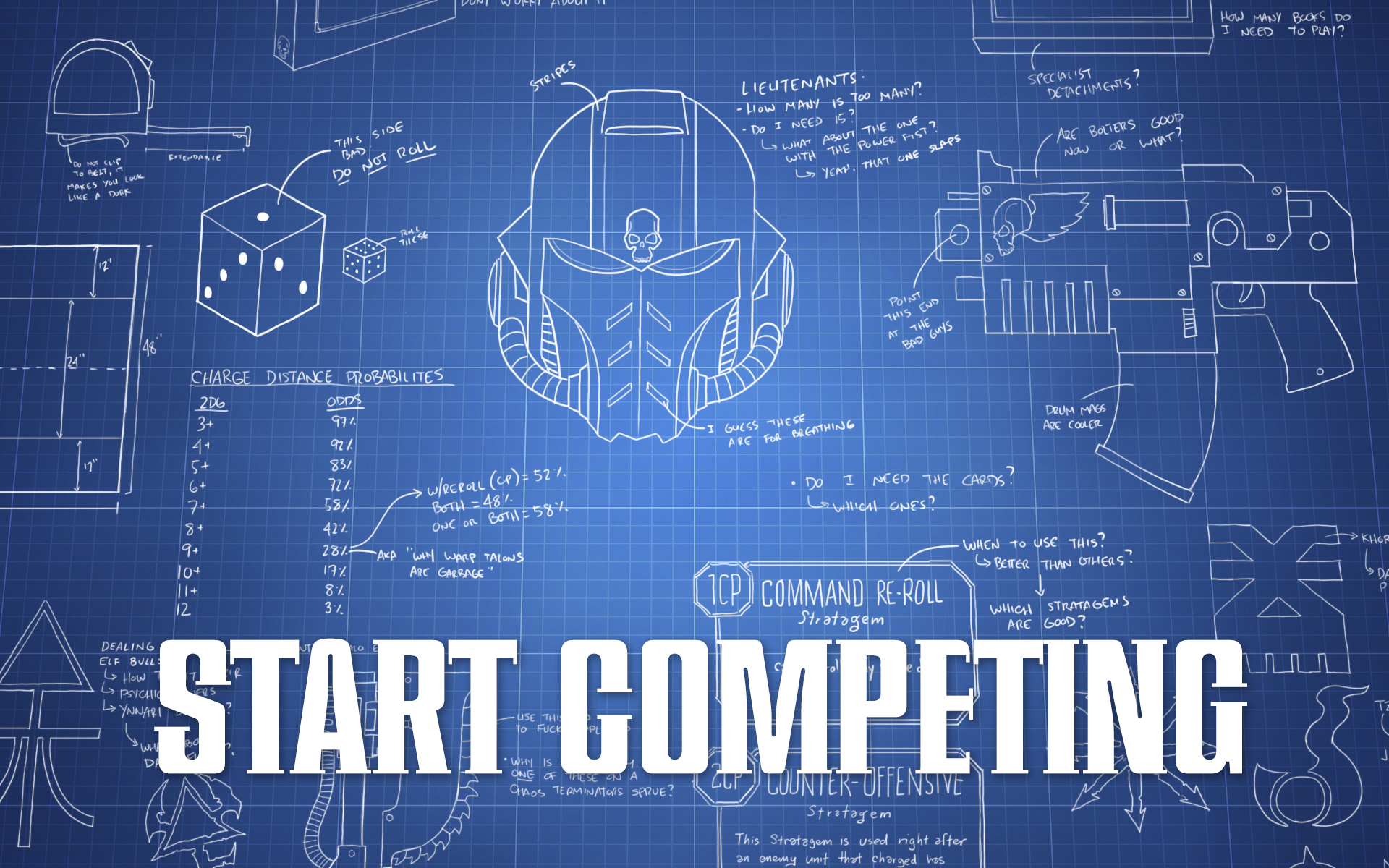As he prepares to head to Renegade this weekend, Cyle “Naramyth” Thompson paused to reflect on how he builds lists and evaluates units, and decided to write up some words detailing the method to his madness.
Fundamentally there are two parts of 40k: Actually playing the game at the table and list building. And there is a huge part of list building that seems to be missed: how to actually evaluate what is good on the table. People will look at things like the Leviathan or Riptide and say “that is good” but often may not grasp the real reason why they’re good. Sure, they both have a lot of wounds and they can pour out a lot of shots, but so can a Land Raider Crusader (and those are bad, Chase). Also people tend to miss or undervalue workhorse type units. The type of unit that isn’t flashy and doesn’t have 20+ shots on a single platform with a huge pool of wounds and an invulnerable save, but rather the type of unit that has surprising durability and/or damage output in a smaller package. And many players tend to look at offensive output but don’t really consider how fragile the unit is. Plasma Inceptors or Helblasters fall into this category: High output, but also not a lot of wounds for the points you spend.
When I build armies, I default to a hard MSU style (Note: MSU stands for “Minimum-Sized Units). Taking a pile of smaller units with a focus on efficiency over effectiveness. To that end, I’ve tried to quantify how I look at units: bricks of bullets and wounds that hopefully provide enough significant shooting for the points on a platform that is cheap or durable enough to justify putting it in a list to begin with.
With that I’ve come up with a few metrics that I use to evaluate units:
Points Per Wound
How many points are you paying for a wound? Board control is a huge part of the game regardless of the format and having points-efficient bodies or hulls just kind of existing is extremely important. This is pretty well understood on the squad level: Guardsmen are 4 PPM, Scouts 11 PPM, but you don’t always see discussion about multi-wound models: A rhino is only 6.7 PPW, the cheapest Wave Serpent is 10.69, Aggressors 12.33, and the Hellblaster at 33. That feels about right. Guardsmen are cheap as chips, aggressors feel pretty fragile sometimes, and Hellblasters are a mega trap.
Points Per Shot
How many dice you get to roll per shooting activation? With this metric, we don’t care about how strong each shot is, just how many shots we’re getting. This makes the guardsmen the most efficient unit in the game, with a 2 PPS in rapid fire range. Though before we put too much into this metric, note that it also places the Crimson Hunter Exarch as one of the worst, at 43.5 PPS. Clearly a raw Points Per Shots calculation doesn’t tell the whole story. A Bright lance should be worth more than a lasgun shot. An autocannon or plasma gun should be somewhere in the middle, as should something like an Assault Cannon or Scatter laser. So I’ve divided up shooting into five broad categories, and given them a multiplier.
Incidental Shooting (IncS)
S4 or less shooting. Bolters, lasguns, shuriken catapults. Most line infantry shooting. Sure a lasgun isn’t as good as a bolter or whatever but it’s all just incidental shooting that shouldn’t expect to do much to anything T4 or better. Incidental shooting gets a 0.5 multiplier.
Shots
S5+ shooting, 1 damage. Heavy Bolters, Scatter lasers, assault cannons, etc. Shooting that is good against a lot of targets. Wounding infantry on 3s or better, and vehicles on 5s is a great break point to be able to really sweep infantry off the table, and with enough volume of fire, to put hurt on vehicles. Shots get a .75 multiplier.
Significant Shooting (SigS)
Significant Shooting (SigS): S5+ 2damage, d3 damage, battle cannons, reliable mortal wounds from Harlie Bikes, auto cannons, plasma guns. If it is a great weapon to deal with heavy infantry or to take down vehicles with moderate volume of fire, shots go here. Significant Shooting does not get a multiplier.
Major Shooting (MajorS)
S8+ d6 damage or flat 3 damage. This is your melta gun, lascannon, krak missile. Those high damage shots that can do some real hurt quickly to large models. Major Shooting gets a 1.25 multiplier.
Super Shooting (SuperS)
S9+ d6flat3, 4+ flat damage, or multiple dice damage shooting. This is where volcano cannons, laser destroyers, and other FW fueled insanity lives. Super Shooting gets a 1.5 multiplier.
Any random number of shots just uses the average. so 3.5 for a d6, 6 for 3d3. I don’t take account for high variance because I’m not a mathologist. higher variance should probably get a 1 shot penalty or something but whatever. Sometimes you have to just make a decision. Ballistic skill factors into this obviously. Less reliable shooting can really skew the numbers so I’ve assumed all the shooting is BS3+, and have given a ~17% penalty to BS4+ and ~17% bonus to BS2+ in my evaluations.
Rapid Fire is also in a weird place. Sometimes you are in range, sometimes you aren’t. In an attempt to quantify that I used a 1.5 multiplier.
Finally I take into account disconnected ranges on a model’s guns for weighting.. Like flamers on a knight. The flamer should be worth something, but if the platform doesn’t want to be at 8″ all the time so it shouldn’t provide all the shots to the calculation. So if there is a range mismatch the flamer is just worth 1 instead of 3.5 or whatever.
Modified Points Per Shot
So why do I weigh things as I do? Because any list needs to get through five or more different armies that could vary wildly so all shots need to have the broadest application. So because incidental shooting is exactly that, and it only really matters in high volumes so I don’t weigh it much more than a bonus chance to roll dice. Conversely, insanely over-damaging shots are extremely useful but tend to be found solely on expensive platforms for which you pay a premium and so they can be overrated. The most reliable shooting against most of the field for all the editions I’ve played in has been the autocannon or its equivalents and getting the highest volume of these medium-value shots has been the best baseline.
Using all of these considerations, we can create a Modified Points Per Shot metric by summing the weighted shots and dividing by the points cost of the unit. Using this metric, the dual-punisher vulture comes out to 5.9, the mighty guardsman is a 6.4, a laser destroyer executioner is 11.17, Callidus 14.94, and the poor rhino at a sad 44.66 Modified Points Per Shot.
And once we have our new points-per-shot metric, we can combine it with the unit’s wounds value to get a more comprehensive view of the unit’s efficiency. Mod Points Per Shots Over Wounds (the name needs to be workshopped ok) further divides the value by the number of wounds to give us a ratio of points to shots and wounds, so we don’t overvalue glass cannons. The Vulture clocks in at a .42, laser repulsor at .69 the Callidus at 1.06, Hemlock at 1.88, the guardsman stays at 6.4, and our picked-last-at-Primairs-kickskull-friend, the Hellblaster at a mighty (read: Dismal) 22.
In the tables below, I’ve made available the data I’ve used for these calculations, sorted by Mod Points Per Shots Over Wounds. This isn’t a definitive metric by any means; the game isn’t exactly oppressed by our Vulture overlords but the Repulsor Executioner is right there in 2nd through 12th with only stops for the Skorpious Disintergrator and the Battlecannon/Ironstorm Crusader. I don’t really believe in the BC Crusader but the Thermal Cannon variant is right there as well. In Non-marine news the boogeyman of summer 2019 the Calludus is still there at 25th, The first Tyranid model the Exocrine shows up in 32nd and the Riptide in 38th.
Towards the bottom of the list things get a little weird. Obviously Large Adult Son Hellblaster is dead last (edit: 4th to last, I had them at one wound), but right next to him is the Firedragon, Scout, Dire Avenger, and a minimum squad of Dark Reapers, and Eliminators, all of which are below the Rhino. Now Reapers might be back in play, Eliminators are actually super good, and scouts and Dires wind up in all sorts of lists and are useful but it is interesting how much they really contribute on the more macro level of removing your opponent’s material off the table.

All of this is is really just a love letter to the best tools in the game: the Skorpious Disintergrator and Dunerider. Way up there in 6/8th place and 23rd. I clearly like the chassis, and my current Admech army runs 7 of the chassis but it really makes sense from these metrics: lots of shots per wound, and lots of relevant shooting per platform. And the transport even holds dudes! On the table they feel way better than they deserve to be as well: always having just a few more wounds than expected, and punching above their weight. They aren’t show stoppers like the Repulsor or a Knight but they are a great consistent platform that gives an army a great baseline of firepower to accomplish their objectives.
Is this the most comprehensive way to evaluate units? Of course not. This doesn’t take into consideration abilities like Doctrines, re-roll bubbles, Psychic powers like Doom/Jink, mobility considerations, Markerlights, or Strategems. This also doesn’t address close combat, like at all. Melee is such a different beast that is both useless and game-winning that I don’t believe it can be quantified in a spreadsheet. However this is a great way to look at units before buffs to see if they’re worthwhile to field on their own merits.
Finally I did make a few tweaks with wounds: If the unit has an innate FNP (usually a 6+++) I added ~17% more wounds to the unit (Editor’s Note: We will likely revisit this rubric in a future article and correct the wound math for FNP).
Doing Your Own Evaluation
Hopefully this has given you some food for thought about how to evaluate units. As I said, it’s not perfect – there are many things it doesn’t take into account – but it gives us a good way to evaluate both the hardiness and effective damage output of a unit to determine what is and isn’t worth putting on the table. If you have thoughts of your own on quantified unit evaluation, feel free to leave a note for us in the comments below or on social media, or shoot us an email at contact@goonhammer.com.


